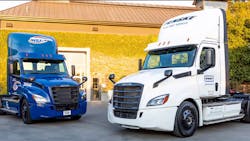Fleet electrification lessons learned
One of the biggest challenges Penske faced when implementing electric vehicle (EV) charging infrastructure was spec’ing the sites to meet its fleet’s needs. That’s why Mike Barnes, Penske’s facilities manager for the Western region, has emphasized the importance of planning ahead while also considering future EV growth.
According to Barnes, the key is working with experienced engineers and contractors to avoid possible delays in charging infrastructure permitting and the overall utility design process.
Barnes spoke at a Sept. 22 session, “Best Practices in Scaling EV Charging Infrastructure for Fleet Operations,” during Advanced Clean Transportation (ACT) Virtual, a four-month online education series on the latest vehicle technology and fueling infrastructure innovations. ACT Virtual is organized by the team that produces the ACT Expo. Barnes was joined by Natalia Swalnick, senior director of EV programs for the Electrification Coalition; Henrik Holland, COO of Greenlots; and Mike Gerty, director of Advanced Research for Paccar.
In 2018, Penske partnered with Daimler Trucks North America (DTNA), Penske Truck Leasing, and NFI to operate the Freightliner Electric Innovation Fleet of eCascadia heavy-duty trucks and eM2 106 medium-duty trucks.
At the start of the electrification project, Penske chose angle parking at its charging infrastructure facilities as opposed to a pull-through approach, as the fleet’s charging cables are 25 ft. long. The key takeaways when designing a facility are knowing where truck charge ports are, the total length of the cables needed, and designing a facility for future growth, Barnes explained.
“Communicate with the utility company on your growth 10 years out,” he advised. “They are going to want to know how much infrastructure you are planning on so they can size their utility correctly based on your system.”
Barnes also stressed the importance of planning ahead as a group.
“You have to anticipate that there will be delays as this gets more and more popular. For permitting and utility timelines, I can’t stress enough to have your team engaged 100%,” he said. “The more you know about your setbacks and your sites, the much quicker your permitting is going to go through.”
Barnes pointed out that Penske initially ran into some unexpected equipment and charging challenges when the supplier upgraded its systems. Penske also found that its commercial drivers exhibited different behaviors while driving electric trucks. When drivers would come back from running their routes, Barnes said those who didn’t use regenerative braking properly brought the truck back with less of a charge than those who had used it correctly. He said this is something fleets should consider when determining the charging equipment they need.
Another challenge is that specialty parts availability for EVs is still somewhat unknown. The key for fleets is to understand their parts availability so their trucks aren’t down for several days at a time, Barnes said. He also urged fleets to plan for unexpected charging problems.
“When those chargers are possibly going to go down due to a power outage, you need to have a supplier or vendor on standby to service your chargers,” Barnes explained. “We want to make sure that we have a response time with a given time of anywhere from four to six hours.”
Recently, Paccar announced that fleets can now order Class 6 and 7 electric trucks from its dealerships. In the coming months, fleets will also be able to order electric Class 8 tractors and straight trucks, Gerty said.
“As the electric truck market starts to kick off, we believe that most of the charging will be done at depots rather than at public locations,” Gerty explained. “The charging power and equipment needs of a truck in a fleet can vary widely depending on the truck model and route, the number and lengths of driving shifts, and how well charging is designed for the operational flow of the fleet.”
Paccar sees three main parts to charging infrastructure. The first is the chargers themselves, which convert the AC power from the grid and the right voltage to charge the truck’s batteries. The second is the infrastructure that provides the DC power to the charger, which in many cases can be more costly and complex than the chargers themselves, Gerty pointed out. Finally, there are connected services that are necessary to manage an electric fleet. These include energy tracking by truck and charger, power controls to reduce energy costs, remote diagnostics and repair charges, and fleet management system integration.
Paccar has also partnered with Schneider Electric and Faith Technologies to provide commercial fleet charging solutions. Peterbilt and Kenworth will provide the electric trucks, chargers and financing. Schneider will provide the equipment that will connect the charger to the grid as well as the controls, microgrid capability, and energy-as-a-service billing models. Faith Technologies will provide the technologies, manufacturing, installation and commissioning, as well as long-term maintenance after sale.
Paccar’s Kenworth and Peterbilt have recently begun taking customer orders for production model Kenworth K270E and the Peterbilt Model 220EV battery electric trucks, with additional production models to be introduced in the coming months.
Relationships with utilities
When it comes to fleets developing relationships with utilities, Greenlots’ Holland emphasized that early involvement of the utility is critical. Greenlots is a provider of EV charging solutions across the globe and was acquired by Shell in January 2019.
“I urge people to also think about working with developers and services providers that have already developed infrastructure in your particular area,” Holland advised. “There is a lot of experience already in the market that you can leverage as you look to developing your projects.”
Gerty added there are temporary solutions that will help fleets who receive their EVs before their charging infrastructure power their vehicles.
At the end of the day, evaluating total cost of ownership is a key consideration and one of the single most important decisions fleet managers will make when transitioning to EVs, regardless of class size.
Swalnick pointed out that route predictability can help reduce the infrastructure needed, as it will help the fleet determine what the impact of the transition to EVs will be. The importance of understanding maintenance costs is also a key piece of the EV deployment puzzle.
“Future-proofing EV charging is also a consideration to align EV charging and deployment,” Swalnick explained. “We have to consider the internal timelines such as procurement, building renovations into the decisions we make and by planning ahead.”
That means, thinking in terms of EV readiness, fleets should consider the number of EVs they have now compared to what they expect to have five, 10 and 15 years from now. A best practice for fleets moving ahead with the process is to also calculate the number of chargers and electric supply they will need ahead of time to lower costs down the road.
About the Author

Cristina Commendatore
Cristina Commendatore is a past FleetOwner editor-in-chief. She wrote for the publication from 2015 to 2023.
